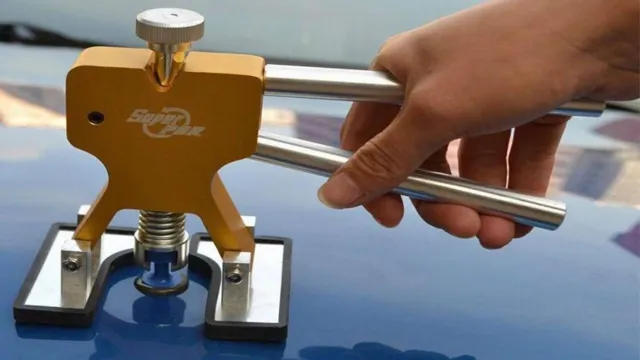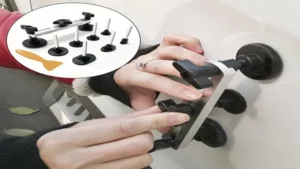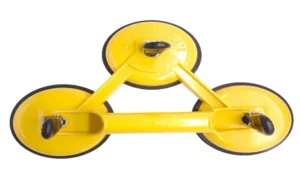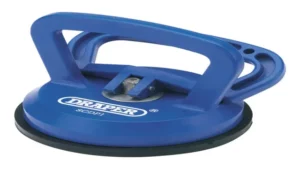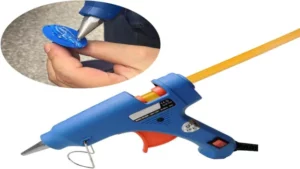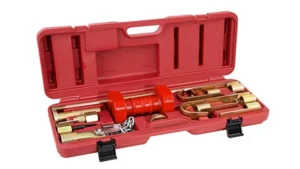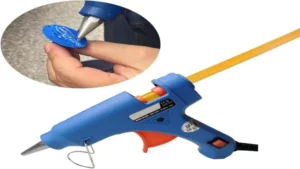Have you ever noticed a small dent on your car, but didn’t want to spend a fortune to get it fixed? Well, that’s where a dent puller comes in handy. A dent puller is a tool used to remove small to medium-sized dents from the body of a car, without damaging the paint or causing any further harm to the vehicle. Using a suction cup-like device, the dent puller creates a vacuum seal and pulls the dent outwards, resulting in a smooth, dent-free surface.
It’s like using a plunger on a sink; the suction pulls out the clog, just as a dent puller pulls out the dent. It’s a simple and affordable solution to a common problem for car owners. In this blog, we’ll dive deeper into the details of what a dent puller is, how it works, and why you should consider this as an option for fixing minor dents on your vehicle.
Definition and Functionality
If you are looking for a quick and affordable solution to fix dents on your car, then a dent puller might just be the tool you need. A dent puller is a device used to remove small and medium-sized dents from a car’s body, without the need for additional painting or bodywork. It works by using suction cups to pull out the dent, and it is available in a variety of sizes and shapes to suit different types of dents.
Dent pullers are designed to be easy to use and can be used by anyone with a bit of DIY experience. They are also a popular choice for car enthusiasts who want to keep their cars looking their best without breaking the bank. Whether you are dealing with a small dent caused by a shopping cart or a larger one caused by a hailstorm, a dent puller can help restore your car’s appearance quickly and easily.
So, next time you notice a dent, don’t panic, just grab a dent puller and get to work!
Explanation of what a Dent Puller Does and How it Works
A dent puller is a tool used to remove dents and dings from cars and other vehicles. It works by using suction to pull the dent out of the body of the vehicle. The suction cup is placed over the dent, and then you use a lever or handle to create the vacuum.
Once the suction is strong enough, you pull the dent out by pressing on the handle. Dent pullers come in many different shapes and sizes, and they can be used to remove small dents or larger dents that are more extensive. They’re a handy tool to have if you’re a DIY car enthusiast or a professional mechanic.
They’re also a less expensive and more convenient option than taking your car to a body shop. Whether you’re removing a dent in your car or adding an extra bit of polish before selling it, a dent puller is an essential tool in any car owner’s toolbox.
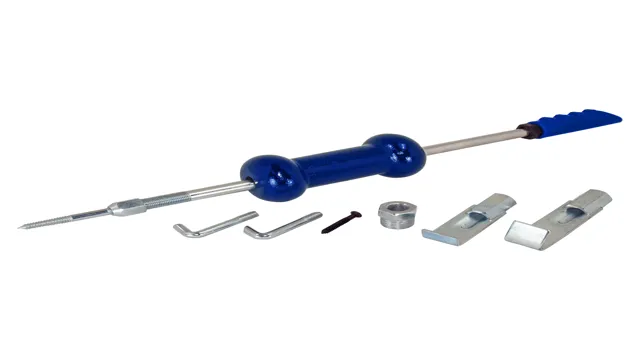
Types of Dent Pullers
So, what is a dent puller, you might ask? A dent puller is a tool used to remove dents or dings in a car’s body. There are several types of dent pullers available in the market, each with its unique features and benefits. First, there’s the suction dent puller that uses suction cups to attach to the dented area and create a vacuum that pulls the dent back into place.
Then there’s the glue-based dent puller that uses hot glue and adhesive tabs to pull out the dent. This type of dent puller is great for smaller dents and dings. Another type is the slide hammer dent puller, which uses a sliding weight and an attachment to pull the dent out of the car’s body.
Finally, the stud welder dent puller uses specialized equipment to create a small hole in the dent, then a stud is welded to the hole, and a puller is used to remove the dent. Each of these dent pullers has its own set of advantages and disadvantages. It’s essential to choose the right kind of dent puller based on the size, location, and shape of the dent that you want to remove.
Overview of Different Types of Dent Pullers Available
Dent pullers are a great solution for getting rid of those unsightly dents on your car’s exterior. There are several types of dent pullers available, each with its own unique benefits. Firstly, we have the suction cup dent pullers that use suction to create a vacuum between the car surface and the cup, allowing it to pull the dent out.
Another popular dent puller is the glue tab dent puller, which involves gluing a plastic tab onto the dent and then pulling it out using a tool. The hammer and dolly dent puller is another traditional option that involves carefully tapping the dent back into place with a hammer and dolly. Finally, we have the PDR dent puller, which is a professional dent removal kit that requires specialized tools and expertise.
Overall, the type of dent puller you choose will depend on the severity of the dent and your personal preference. Whether you’re a DIY enthusiast or a professional, there’s a dent puller out there for every situation.
Manual Dent Pullers
Manual dent pullers are an effective tool to remove dents from vehicles without causing any damage to the surrounding areas. There are different types of dent pullers available in the market, each offering its own unique features and benefits. One of the most popular types of dent pullers is the suction cup dent puller.
This type of puller uses a strong vacuum to create suction on the surface of the dent, allowing you to pull it out manually. Another popular type of dent puller is the slide hammer, which uses brute force to knock out the dent from the panel. This type of dent puller requires a bit more skill and experience to operate, but it can be highly effective in removing larger dents.
Lastly, the glue gun dent puller is another popular option. This type of puller uses hot glue to attach a small tab to the surface of the dent, which is then pulled out using a specialized tool. Whether you’re a DIY enthusiast or a professional mechanic, there is a manual dent puller on the market that will fit your needs and budget.
Electric Dent Pullers
If you’re looking for an efficient and quick way to remove dents from your vehicle, electric dent pullers are an excellent option. There are several types of electric dent pullers available, each with its unique features and advantages. One type is a slide hammer, which uses a weight on a sliding mechanism to pop out dents.
Another type is a glue-pulling dent remover, which uses hot glue and suction cups to lift dents out. A third type is an electromagnetic dent remover, which uses strong magnetic fields to pull out dents. Regardless of which one you choose, electric dent pullers are a reliable way to remove frustrating dents from your car or truck.
They can save you time and money, as they’re more affordable compared to traditional body shop repairs. Plus, with the right technique and some practice, you can easily become a dent removal expert yourself with these dent pullers!
Benefits of Using a Dent Puller
A dent puller is a tool used to remove small dents and dings from a vehicle. It works by suctioning onto the dent and pulling it out from the car’s body. Using a dent puller can save you time and money compared to taking your car to a body shop to get the dent removed.
It’s also a more eco-friendly option as it doesn’t involve any chemicals or materials being used. Additionally, by removing dents from your car, you keep the value of your vehicle higher which can be beneficial if you plan on selling it in the future. All in all, using a dent puller is an efficient and cost-effective way to restore the look of your vehicle.
Saves Time and Money Compared to Traditional Dent Repair Methods
A dent puller is an efficient and affordable way to repair dents on your vehicle compared to traditional dent repair methods. The benefits of using a dent puller are numerous. For one, it saves time and money.
With a dent puller, you can repair minor dents in a matter of minutes, without the need for expensive equipment or professional help. This is because the dent puller uses suction to pull the dent out from the inside of the panel, rather than using filler or sanding down the area. The result is not only fast and efficient, but also saves you money on costly repairs.
Another benefit of using a dent puller is the convenience. You can easily carry a dent puller in your trunk or toolbox, making it ideal for roadside emergencies or quick fixes. Additionally, it’s a simple process that doesn’t require any prior experience or technical knowledge.
Anyone can use a dent puller, and with several different types of pullers available, you can choose the one that works best for your needs. Lastly, a dent puller is a non-invasive method of repairing dents on your vehicle. It doesn’t require drilling holes or sanding down the panel, which means that the integrity of your vehicle’s body is maintained.
This is important, especially if you’re planning to resell your car or want to keep it looking its best. With a dent puller, you can have your car looking like new again without compromising the quality of your vehicle. In conclusion, there are many benefits to using a dent puller to repair dents on your vehicle.
It’s an efficient, affordable, and convenient method that saves you time and money. Plus, it’s non-invasive, meaning that your car’s body remains intact. So the next time you have a minor dent, consider using a dent puller.
Preserves the Vehicle’s Original Paint
When it comes to dent repair, using a dent puller is one of the best options out there. One of the main benefits of using a dent puller is that it preserves the original paint of your vehicle. The traditional method of repairing dents involves sanding and repainting the affected area, which can be a costly and time-consuming process.
On the other hand, a dent puller uses a specialized tool that gently pulls the dent back into shape without causing any damage to the paint finish. This helps to restore the original look of your vehicle while also saving you money on expensive paint repairs. Additionally, using a dent puller is a non-invasive process, meaning that you don’t need to worry about any further damage to your vehicle.
Overall, a dent puller is a safe and efficient way to repair dents on your vehicle while also keeping it looking like new.
Factors to Consider When Choosing a Dent Puller
A dent puller is a tool that is used to remove dents from the surface of a vehicle. There are a variety of factors to consider when choosing a dent puller, including the size and depth of the dent, the material that the vehicle is made of, and the type of dent puller that is needed. Some dent pullers use suction to pull the dent out, while others use a combination of heat and pressure to reshape the metal.
It is important to choose the right dent puller for the job in order to achieve the best results. Factors to consider include the strength and durability of the tool, as well as its ease of use. It is also important to consider the cost of the dent puller and whether or not it is a cost-effective solution for removing the dent.
Overall, a dent puller can be an effective way to remove dents from a vehicle, but it is important to do your research and choose the right tool for the job.
Size and Shape of Dents
When it comes to fixing dents on your car, choosing the right dent puller can make all the difference. One important aspect to consider is the size and shape of the dent. If the dent is small and shallow, a suction dent puller may be all you need to fix it.
However, if the dent is larger and deeper, you may want to consider a more heavy-duty dent puller such as a slide hammer or stud welder. Furthermore, the location of the dent can also impact which dent puller to use. For instance, if the dent is in an area that is difficult to access, you may need a dent puller with a longer reach or a specialized tool.
Overall, taking the time to assess the size and shape of the dent can help you choose the right dent puller for the job and achieve the best results. So, whether you’re dealing with a small ding or a larger dent, make sure to consider the size and shape of the damage when selecting your dent puller.
Type of Vehicle and Material of the Body
When it comes to choosing a dent puller for your vehicle, there are several factors to consider, with the type of vehicle and material of the body being two important factors. Different types of vehicles may require different tools or approaches to remove dents effectively. For instance, smaller cars may require a dent puller with a more precise tip and a smaller suction cup, while larger vehicles may benefit from a dent puller with a wider suction cup.
Similarly, the material of the body can also affect the choice of a dent puller. For example, aluminum-bodied vehicles may require a different type of dent puller than those made of steel. Keep in mind that the material of the body will determine the amount of force and technique required to remove the dent without causing further damage.
Ultimately, selecting the right type of dent puller will depend on your vehicle’s specific needs, so it’s always best to consult with a professional for guidance.
Conclusion
In conclusion, a dent puller is like a magician’s wand for your vehicle, able to make dents disappear with a wave of its power. It’s a tool that employs the forces of physics to gently coax metal back into its original shape, without the need for costly repairs or invasive procedures. Whether you’ve got a small ding or a major dent, a dent puller is the savvy solution for getting your ride looking pristine once again.
So forget about those unsightly dents and embrace the power of the dent puller – your car (and your wallet) will thank you!”
Summary of the Importance and Benefits of Dent Pullers
If you’ve ever found yourself in a situation where your car has suffered a dent or two, you’ll understand the importance of a good dent puller. Not only does it make your car look better but it can also help retain its value. When it comes to choosing the right dent puller, there are several factors you should consider.
Firstly, you need to decide which type of dent puller you require. There are suction dent pullers, glue gun dent pullers and slide hammer dent pullers. Each has its own pros and cons, and you’ll need to assess your needs to determine which one is the best fit.
Additionally, you should look for a dent puller that has a good grip, ensuring it won’t slip or come off the surface during use. It’s also a good idea to choose one that is easy to use and maneuver. The better the grip and control you have, the more accurate your results will be.
Ultimately, you want a dent puller that is effective, easy to use and durable. With a little research and consideration, you’ll be able to find the perfect one for your needs.
FAQs
What is a dent puller and how does it work?
A dent puller is a tool used to remove small to medium-sized dents from car panels. It works by creating a vacuum between the panel and the tool, allowing it to grip onto the dent and pull it out.
Can I use a dent puller on any type of car panel?
Dent pullers work best on flat or slightly curved panels. They may not be as effective on heavily curved or irregularly shaped panels.
Are dent pullers easy to use?
Dent pullers can be easy to use, but they do require some practice and patience. It’s important to follow the manufacturer’s instructions carefully and take your time to achieve the desired result.
How much does a dent puller cost?
The cost of a dent puller can vary depending on the type and quality of the tool. Basic hand-held dent pullers can be as little as $10, while more advanced electric or pneumatic dent pullers can cost several hundred dollars.
Will a dent puller damage my paint?
When used correctly, a dent puller should not damage your paint. However, if you use too much force or leave the tool in one spot for too long, it is possible to damage the paint. It’s important to be careful and gentle when using a dent puller.
What should I do if the dent puller doesn’t work?
If the dent puller doesn’t work, you may need to try a different technique or tool to remove the dent. Alternatively, the dent may be too large or complex to be removed with a dent puller, and you may need to take your car to a professional repair shop.
Can I use a dent puller on a plastic bumper?
Dent pullers are generally not recommended for use on plastic bumpers, as they can cause damage or deformities to the material. It is best to use a specialized repair technique for plastic bumpers.
